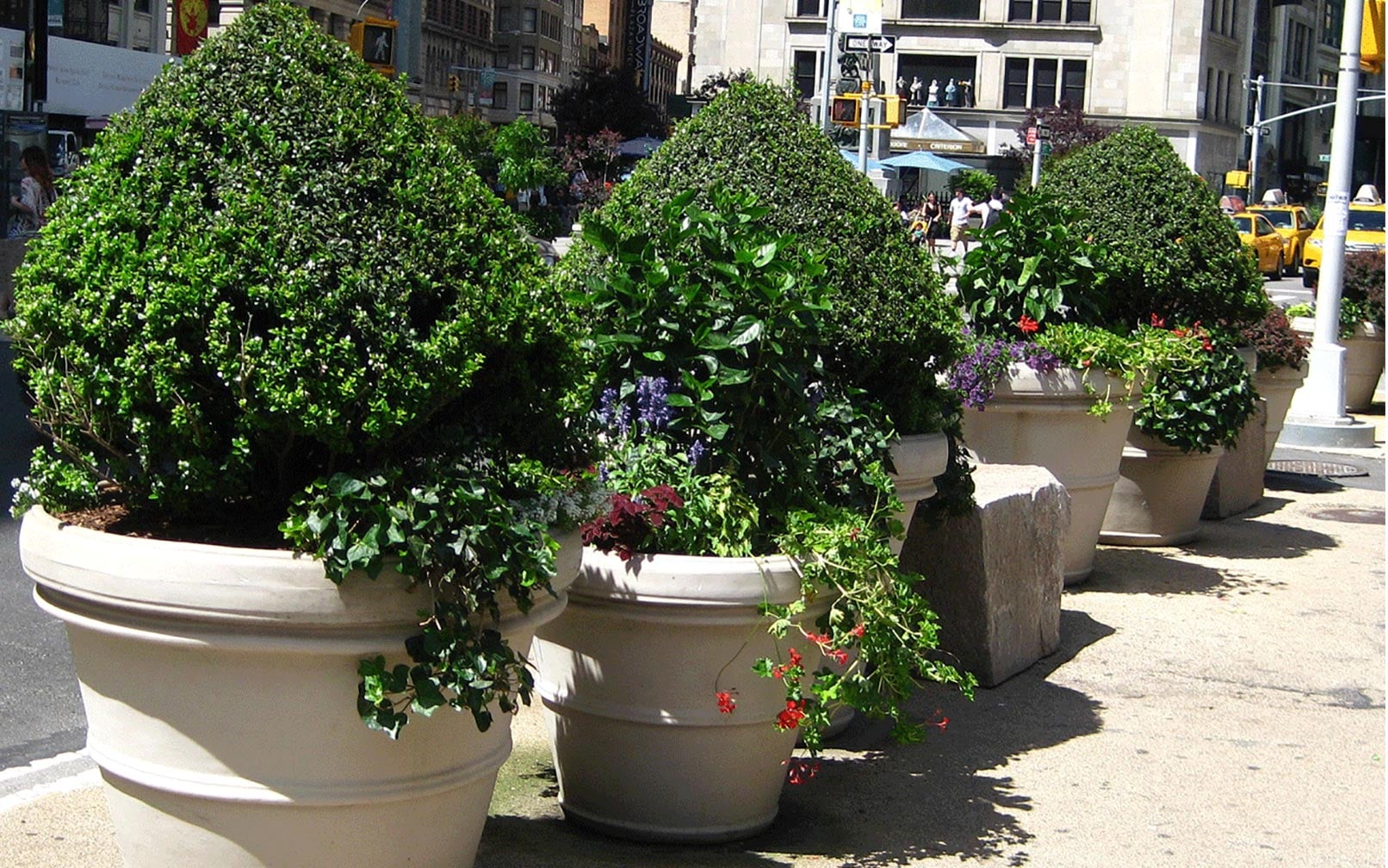Large commercial planters need to be as easy to maintain as possible, that’s why we make large commercial planters that require little to no maintenance. Most other planters on the market require extensive maintenance or else they begin to break down within as little as a few seasons.
Planters create a welcoming and well-maintained appearance for your business or home, but if planters turn into unmaintained messes they can backfire on you and create an unprofessional appearance. For instance, the average stone, clay or plastic planter will start to break down when temperatures dip below 32 degrees F. That means in the winter these planters need to be brought inside to prevent them from cracking and breaking. On the other hand, our planters can survive in temperatures as low as -40 degrees F.
TerraCast Planters require little to no maintenance thanks to our resin-blend materials and special manufacturing process. Our planters are non-porous, meaning they don’t stain from graffiti or absorb damaging moisture. Plus they are lightweight and incredibly durable.
Traditional plastic, stone or clay planters are not very durable and require a great deal of maintenance. So while the following steps to maintain large commercial planters are important, some of them don’t apply to our uniquely low-maintenance and long lasting planters.
Maintaining Large Commercial Planters
#1. Drainage For Large Commercial Planters
Large commercial planters should be self-watering or have some type of drainage hole in order to release excess water and prevent root rot. If your planter sits directly on the ground and the drainage hole is at the bottom of the planter, not much moisture can escape. As a result, your plant roots remain submerged in water, leading to root rot. In order for water to properly drain you’ll need to set your planters on a raised platform of some type.
A solution to this is to invest in self-watering planters. We make an additional self-watering basin that can attach to the bottom of any of our planters, turning it into a functional self-watering planter. This allows excess water to drain down into a storage basin where the roots can reach down and drink as needed, but they are not stuck submerged in water.
Learn more about our self-watering planters: https://docs.google.com/document/d/1Sc9v4RMktIsCiv39DiDvLfA8Km-lA1iP0ymLAULmDVU/edit?ts=58b8f85a
#2. Make Sure Planters Are Safe During Harsh Weather Conditions
TerraCast Planters are uniquely strong in that they can survive a much wider range of temperatures than traditional planters. While your average plastic or stone planter will start to crack if kept out in 32 degree F weather, our planters can survive in temperatures as low as -40 degrees F, or temps as high as 140 degrees F.
You may still want to transport planters inside during harsh weather in order to protect your plants. Our planters are highly durable but they are also lightweight, making them easy to transport as needed.
#3. Transplant Plants As Needed
Over time your plants may start to outgrow their enclosures, just as humans outgrow their clothes, cars and houses. If plant roots grow too big for a planter, they can actually break out through the sides of certain planter materials. Long before roots have a chance to grow this unruly, you should move the plant to a larger planter.
In order to properly transplant plants, the roots should not be damaged during the process. Carefully dig out around the soil in aims of keeping roots completely intact. If plant roots are damaged there is still a chance the plant will survive, but damages increase the level of stress and potential for transplant failure.
#4. Make Sure Planters Are Not In The Way Of Traffic
Make sure to place your planters in a good location where they do not trip people up or are easily knocked into by cars, golf carts, etc.
#5. Sterilize Planters Before New Plants Move In
In order to prevent the spread of plant diseases, thoroughly wash and sterilize your planters before you put a new plant inside. This will not only prevent the spread of diseases, but it’ll also prevent the spread of mold and parasites.
How to sterilize your planters:
Use dish-liquid soap and water to remove clumps of soil or hard water stains.
Mix one parts bleach with 9 parts water and let this concoction sit in the planter for around 3 hours. Instead of a bleach mixture, you could use a commercial gardening sterilizer.
Make sure to thoroughly rinse and remove all of the bleach. You may want to let the planter soak in clean water for an addition few hours.
#6. Fix Planter Cracks
If you have TerraCast Planters you don’t have to worry about fixing cracks in your planters. Our planters are made differently than the rest with a non-porous makeup that prevents water penetration, the leading cause of cracks. Plus they are incredibly flexible so they can handle a lot of hits and bruises without cracking or breaking.
Most other planter materials are at risk for cracking due to a number of natural factors, such as freeze and thaw cycles. As planters incur cracks or holes, they need to be fixed right away or else damages increase to the point the entire planter cracks in half.
#7. Treat Wood & Metal Planters
Wood and metal planters require a whole host of additional maintenance to prevent them from rotting. You should spray wood and metal planters with a non-toxic waterproofing of some type. Also, line wood and metal planters with plastic tarp to further protect materials from moisture penetration, as well as to prevent potential chemicals in the wood from damaging plants. Don’t forget to cut holes in the bottom of the plastic so that water can still drain out.
The Most Low Maintenance Planters On The Market Made Right Here In The USA
TerraCast Products are like nothing else on the market. Since 1969, we’ve been crafting the highest quality products, all made right here in the USA. Learn more about our unique planter materials and manufacturing process: https://www.terracastproducts.com/resin-vs-stone/

